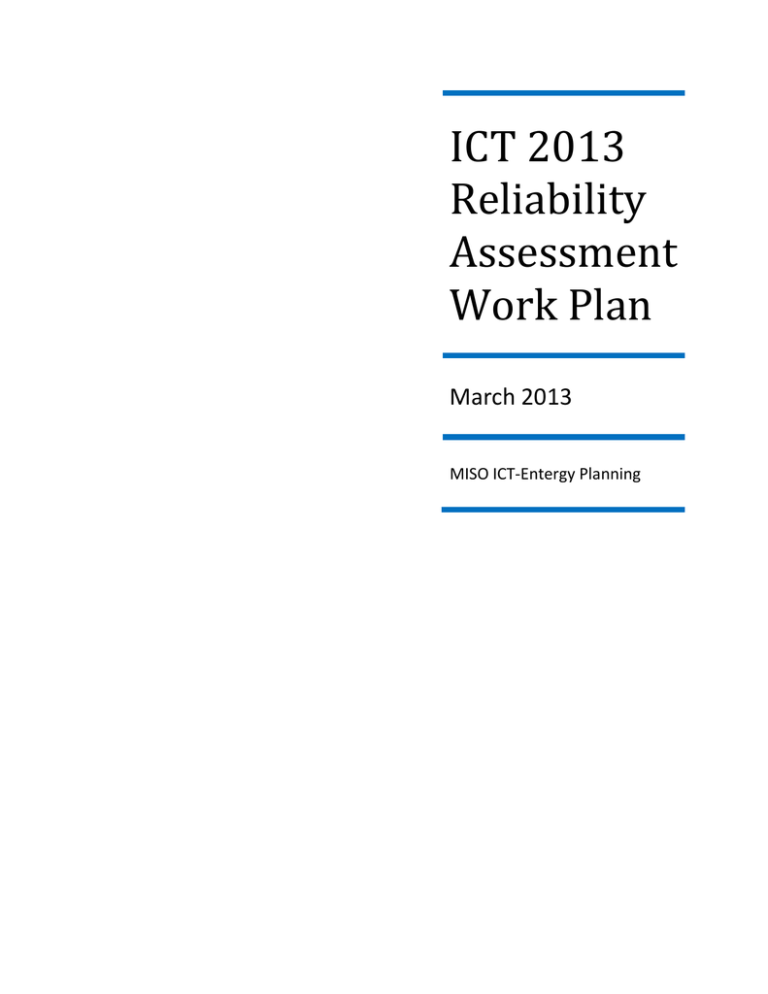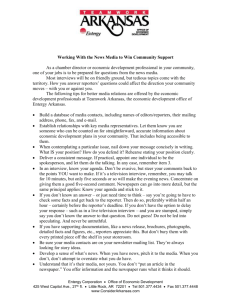DRAFT_Entergy_ICT_Reliability_Assessment_and_Modeling_Scope 03272013.docx Updated:2013-03-28 09:05 CS
advertisement

ICT 2013 Reliability Assessment Work Plan March 2013 MISO ICT-Entergy Planning Contents 1. Purpose ............................................................................................................................................. 2 2. Modeling Process Overview.............................................................................................................. 3 3. Modeling Data & Assumptions ......................................................................................................... 4 4. High-level Modeling Procedure ........................................................................................................ 8 5. Steady State Analysis Overview ...................................................................................................... 10 6. Steady State Analysis Assumptions and Process ............................................................................ 10 7. Information Exchange ..................................................................................................................... 11 8. Process Overview and Schedule ..................................................................................................... 13 ICT 2013 Reliability Analysis Scope 1. Purpose As the Independent Coordinator of Transmission (ICT) for Entergy, one of MISO’s responsibilities is to develop transmission system models and perform analysis needed for long term reliability assessment, in compliance with the Entergy ICT contract and Attachment K of Entergy’s OATT. The purpose of this document is to outline the tasks that are to be performed by MISO as part of the ICT Reliability Assessment. MISO tasks associated with tariff administration and studies conducted in support of Generation Interconnection and Transmission Service requests are not included in this document. The purpose of this document is to: 1) Provide high-level process and timeline overview for the modeling and reliability assessment processes 2) Provide details about data used in developing models and performing analyses 3) Describe the assumptions and tasks involved in building planning models and performing reliability analyses 4) Specify the timeline for the work involved, including the information exchange schedule Page | 2 ICT 2013 Reliability Analysis Scope 2. Modeling Process Overview September-November Data Collection November - December Model Development - Update 0 •Load information •Resource forecast •Merit Order list •Transmission Service •SERC powerflow cases January - February •Develop Base Case & Construction Plan models •Validate models •Post Update 0 models August Quarterly Update – Update 1 April Quarterly Update – Quarterly Update – Update 3 Update 2 •Changes to transmission service, facility approval status, equipment commissioning •Data Corrections •Validate and post models •Changes to transmission service, facility approval status, equipment commissioning •Data Corrections •Validate and post models •Apply latest load forecast •Reflect latest transmission/generation/ transaction changes in models •Data Corrections •Validate and post models Page | 3 ICT 2013 Reliability Analysis Scope 3. Modeling Data & Assumptions As the ICT for Entergy, MISO will coordinate with Entergy in the development of power flow cases needed for planning studies. The following modeling information will be used to develop the models: 1) SERC Long-term Study Group (LTSG) and SERC Near-term Study Group (NTSG) power flow models: The LTSG and NTSG models are developed by SERC to meet NERC compliance obligation per the NERC MOD standards. The Entergy Operations model originates from an NTSG model, updated by Entergy Transmission Operations Planning group to reflect the latest available system information. These cases are used as starting points for the Entergy ICT power flow model development. 2) Generation and Load forecasts: Resource planners at Entergy’s SPO provide future generation information for the Entergy BA, the overall/aggregate load value for the Entergy BA, and the merit order dispatch the Entergy Operating Companies’ generation. Network customers provide load and resource forecasts for their loads. Major Accounts provides forecasts of large industrial customers when available. Entergy Distribution companies provide detailed load forecasts on a bus by bus basis. Transmission service information is obtained from the OASIS. Entergy SPO provides system-wide merit order list to dispatch Entergy generation, and Independent Power Producers (IPPs) are dispatched based on their transmission service level. Page | 4 ICT 2013 Reliability Analysis Scope 3) Future transmission: This information is provided by Entergy’s transmission planning organization. Broadly, there are two sets of transmission data in Entergy’s Construction Plan: a. Base Plan (BP) Upgrades: Transmission projects for which construction needs to be initiated within the next 5 years, as defined section 1.2 of Attachment T to the Entergy OATT. Reliability criteria include NERC Reliability Standards, SERC standards, Entergy Transmission Local Planning Criteria and ICT criteria. b. Supplemental Upgrades: Transmission projects as defined in section 1.3 of Attachment T the Entergy OATT. The projects above can be either “approved for funding” or “proposed.” Only the projects approved for funding will be included in the Construction Plan models. The Base Cases will exclude all future transmission facilities except those which are necessary to model firm transmission service from new sources, (see Transmission Assumptions below). 4) Balancing Authorities : The following balancing authorities are considered as internal to the Entergy’s Transmission System for the purposes of the ICT Reliability Assessment: Plum Point Control Area (PLUM) Osceola Municipal Light and Power (OMLP) Batesville Control Area (BCA) Louisiana Generating (LAGN) City of Conway (CWAY) City of Ruston (DERS) Benton Utility Balancing Area (BUBA) Panda Union Power Partners (PUPP) City of North Little Rock (NLR) City of West Memphis (WMEM) Brazos (BRAZ) Assumptions about the models to be built are provided below: 1) Scenarios: Powerflow cases need to be built to represent a 12 year planning horizon. Summer peak load, winter peak load and two light load cases will be built. See Table 1 below for specific cases to be built. Page | 5 ICT 2013 Reliability Analysis Scope Sr. No. 1 2 3 4 5 6 7 8 9 10 11 12 13 14 15 16 17 18 19 20 21 22 23 24 25 26 Table1: Powerflow models to be built (26 seasons X 2 transmission scenarios = 52 models to be developed) External Representation Model SERC LTSG Case Name (from SERC LTSG cases) 2013 Summer Peak 2013 Summer Peak LTSG13S-FINAL.sav 2013 Winter Peak 2013 Winter Peak LTSG13W-FINAL.sav 2014 Summer Peak 2014 Summer Peak LTSG14S-FINAL.sav 2014 Winter Peak 2014 Winter Peak LTSG14W-FINAL.sav 2015 Summer Peak LTSG16S-FINAL.sav 2016 Summer Peak * 2015 Winter Peak LTSG16W-FINAL.sav 2016 Winter Peak 2015 Light Load LTSG13L-FINAL.sav 2013 Light Load* 2016 Summer Peak 2016 Summer Peak LTSG16S-FINAL.sav 2016 Winter Peak 2016 Winter Peak LTSG16W-FINAL.sav * 2017 Summer Peak LTSG18S-FINAL.sav 2018 Summer Peak 2017 Winter Peak LTSG18W-FINAL.sav 2018 Winter Peak* 2018 Summer Peak 2018 Summer Peak LTSG18S-FINAL.sav 2018 Winter Peak 2018 Winter Peak LTSG18W-FINAL.sav 2018 Light Load 2018 Light Load LTSG18L-FINAL.sav 2019 Summer Peak 2019 Summer Peak LTSG19S-FINAL.sav * 2019 Winter Peak LTSG18W-FINAL.sav 2018 Winter Peak 2020 Summer Peak LTSG19S-FINAL.sav 2019 Summer Peak* 2020 Winter Peak LTSG18W-FINAL.sav 2018 Winter Peak* * 2021 Summer Peak LTSG23S-FINAL.sav 2023 Summer Peak * 2021 Winter Peak LTSG23W-FINAL.sav 2023 Winter Peak * 2022 Summer Peak LTSG23S-FINAL.sav 2023 Summer Peak * 2022 Winter Peak LTSG23W-FINAL.sav 2023 Winter Peak 2023 Summer Peak 2023 Summer Peak LTSG23S-FINAL.sav 2023 Winter Peak 2023 Winter Peak LTSG23W-FINAL.sav 2024 Summer Peak LTSG23S-FINAL.sav 2023 Summer Peak* * 2024 Winter Peak LTSG23W-FINAL.sav 2023 Winter Peak Where exact match is unavailable, external system is modeled using closest available LTSG case. Page | 6 ICT 2013 Reliability Analysis Scope 2) Transmission Assumptions: Two sets of cases will be built – the first set of Base Cases will contain almost no future transmission projects. The only future transmission projects these cases will contain are the interconnection facilities needed to incorporate future generators that have firm transmission or interconnection service. The second set of Construction Plan Models includes all approved facilities in Entergy’s Construction Plan. These are “approved for funding” enhanced reliability, economic, and interconnection/transmission service driven projects for which construction needs to be initiated within the next 5 years. The Construction Plan may contain both Base Plan Upgrades and Supplemental Upgrades. Base Case models are used as the starting point for the Construction Plan models. The cutoff dates for including future transmission in Summer Peak cases is June 1st of that model year and December 1st for Winter Peak cases. The Light Load models contain the same transmission projects as the prior year Winter Peak models. Construction Plan models developed by MISO ICT beginning December 1, 2012 will include the projects in Entergy’s 2013-17 Construction Plan. 3) Generation Assumptions: Generator information provided by network customers and Entergy resource planners will be utilized. Existing generators and planned generators with both interconnection service and long-term firm transmission service will be modeled. 4) Generation Dispatch: Generators will be dispatched using a block merit order dispatch. The merit order list contains all of Entergy’s network resources (NRs), and is provided by Entergy’s SPO group. Network customers’ resources will be dispatched by a merit order provided by the customer. If no merit order is provided, resources will be dispatched according to OASIS reservation priority. Entergy only dispatches generators without firm transmission service if there is generation deficiency with all of the NRs dispatched. IPPs are dispatched based on their available long-term firm transmission service. Qualifying Facilities (QFs) are dispatched only to meet their on-site load unless they have surplus firm transmission service, in which case they are dispatched to meet the firm service and on-site load level. 5) Net Scheduled Interchange (NSI): Power flow cases are solved with area interchange enabled (Ties + Loads solution method is utilized). The SERC LTSG interchange workbook is used as the starting point for NSI values in the models. NSI is honored for Entergy as a whole. All transmission service reservations within Entergy are replaced with OASIS transaction data. 6) External system modeling: External system representation is obtained from SERC LTSG cases as noted in Table 1 above. Page | 7 ICT 2013 Reliability Analysis Scope 4. High-level Modeling Procedure As required in Attachment K of the Entergy OATT, power flow models are developed annually starting in fall and are updated quarterly based on the latest information available. The details of the initial model development and the subsequent quarterly updates are as follows: 1) Initial Model Development - Update 0 Model development will begin with the SERC LTSG and NTSG cases. The LTSG cases are used to model the external (non-Entergy) system representation (see Table 1 above). The Entergy system is modeled using Entergy Transmission Operations Planning cases (which are developed from SERC NTSG models). For ICT 2013 cases, the 2013 summer peak and winter peak cases will be used as the starting point and updated with PSS/E change files (idevs) received from Entergy transmission planning group to appropriately model the desired future scenarios. The idevs will update the following information: a. Current and planned transmission topology b. Load levels c. Generation assumptions d. Net scheduled interchange, including transmission service assumptions All subsequent cases will be updated with PSS/E change files to represent the appropriate seasonal load, generation, and transmission topology. Entergy will build the Base Case and Construction Plan models and provide to MISO for validation and posting. Timeline – Posted in December 2012 Page | 8 ICT 2013 Reliability Analysis Scope 2) Quarterly Update – Update 1 The new load forecast as provided by Entergy’s SPO, Distribution, and Major Accounts groups, as well as network customers will be applied to the models. Corrections and updates to topology, generation or transactions will also be applied. Timeline – Posted in January/February 2013 3) Quarterly Update – Update 2 The powerflow cases will be updated to reflect changes to transmission service, facility approval status, equipment commissioning and other changes as necessary. Timeline – Posted in April/May 2013 4) Quarterly Update – Update 3 The powerflow cases will be updated to reflect changes to transmission service, facility approval status, equipment commissioning and other changes as necessary. Timeline – Posted in August/September 2013 Models will be posted on Entergy’s OASIS as outlined in Section 10.2 of Entergy Tariff Attachment K. Page | 9 ICT 2013 Reliability Analysis Scope 5. Steady State Analysis Overview Set study assumptions Determine final transmission plans Run initial steady state analysis Gather and test alternatives Determine initial constraint mitigation Run full steady state analysis Document and report 6. Steady State Analysis Assumptions and Process MISO will conduct steady state analyses from March to June. 2015, 2018, and 2023 summer peak, and 2018 winter peak and light load scenarios will be tested against NERC TPL standards and Entergy Planning Criteria. All contingencies applicable to the standard will be tested against each of the five models. Where transmission upgrades are needed to mitigate identified constraints, the MISO ICT will collaborate with Entergy planning staff to develop appropriate network upgrades for inclusion in the Base Plan. 1. December / January: MISO will create a difference report. This is list of projects that are included in the SPP’s 2013 Base Plan, but not in Entergy’s 2013-2017 Construction Plan or likewise not in the Base Plan but in Entergy’s Construction 2013-2017 Plan. Additionally, this may also include difference in recommended in-service dates of projects included in both Construction Plan and Base Plan. 2. April: Non NERC Category C3 AC steady-state contingency analysis. System adjustments consistent with NERC and Entergy planning criteria will be applied. Page | 10 ICT 2013 Reliability Analysis Scope 3. April 1st: Entergy submits its DRAFT 2014-2018 Construction Plan 4. April – May: Test projects to mitigate identified issues. Mitigation projects submitted by Entergy may include projects not approved in the 2013-2018 Construction Plan or Horizon Plan projects. 5. May – June: Identify outstanding constraints, develop additional projects in collaboration with Entergy (to mitigate issues where no available Construction Plan, Horizon Plan projects exist or the submitted construction plan projects are deemed ineffective). Include all projects needed to mitigate ICT reliability issues in the final models. Projects included in items #4 and #5 would constitute MISO’s preliminary Base Plan to be presented at the 2nd ICT Planning Workshop. 6. June: Full AC steady-state contingency analysis (Including C3 Contingencies) 7. July – August: Test alternatives to proposed projects. This may include demand side management and generation alternatives as submitted by stakeholders 8. August – September: Finalize Base Plan (this may include rejecting previously considered projects over more effective alternatives submitted by stakeholders) and where applicable, coordinate with Entergy on revisions to the Construction Plan. Upon integration into the MISO RTO, Entergy will submit this Construction Plan as an input into MTEP14 planning cycle. 9. September – October: Create a full ICT Reliability Assessment Report. 7. Information Exchange In addition to interfacing with stakeholders at public forums such as Transmission Summits and the ERSC, the MISO ICT will interface with stakeholders throughout the ICT planning process via email, as well as by: 1. Holding an ICT Planning Workshop in February 2013 to discuss updates to Entergy Planning Criteria, Modeling Assumptions, ICT Study Scope as well as MISO Differences Report (Difference between Entergy’s 2013-2017 Construction Plan and SPP’s Base Plan). Meeting notification as well as meeting materials were posted on the MISO website, and this meeting was held on February 27, 2013.. 2. Posting Entergy’s draft Construction Plan on Entergy’s OASIS, send out notification to all stakeholders and solicit feedback for comments in March 3. Posting MISO ICT’s draft Base Plan on Entergy’s OASIS, send out notification to all stakeholders in June 4. Holding a 2nd ICT Planning Workshop in July 2013 to present draft ICT Base Plan. Entergy will present its draft Construction Plan. MISO will also highlight and seek to resolve outstanding issues on SPP’s 2013 Base Plan vs. Construction Plan Differences Report. Solicit feedback for comments and alternatives to proposed projects at the meeting and subsequent emails. Meeting notification as well as meeting materials will be posted on MISO website. 5. Posting all comments received on Entergy’s OASIS, including MISO responses where applicable. Page | 11 ICT 2013 Reliability Analysis Scope 6. Posting the final Base Plan and Construction Plan, email notification to all stakeholders, and solicit feedback for comments in August. 7. Holding a Transmission Summit in September 2013 to present the final ICT Base Plan. Entergy will present its final Construction Plan. MISO ICT will highlight differences between the plans where applicable, and review all comments received from stakeholders. Meeting notification as well as meeting materials will be posted on MISO website. 8. Presenting final Base Plan to the E-RSC in November 2013. Page | 12 ICT 2013 Reliability Analysis Scope Appendix 1: Process Overview and Schedule Page | 13 ICT 2013 Reliability Analysis Scope Appendix 2: Monitored Elements and Contingencies Monitored Elements Entergy Internal o Transmission elements within Entergy’s footprint (including embedded Areas) with nominal voltage 69 kV and higher. o Ties to outside Areas at 69 kV and higher. CLECO & Lafayette Utilities System o Transmission elements with nominal voltage 69 kV and higher. All other first-tier Areas o Transmission elements with nominal voltage 345 kV and higher. Contingencies Category A Monitored elements must remain within the thermal and voltage limits specified in Entergy’s Transmission Local Planning Criteria o Flows less than 100% of RATE A o Voltages between 0.95 and 1.05 per unit. o Elements within CLECO and SPP will use RATE B as their thermal limit Identify all elements that do not meet the Category A limits and propose mitigation Category B All NERC Category B contingency events will be analyzed o Includes single line, single transformer, or single generator outages Monitored elements must remain within the thermal and voltage limits specified in Entergy’s Transmission Local Planning Criteria o Flows less than 100% of RATE A o Voltages between 0.92 and 1.05 per unit. o Elements within CLECO and SPP will use RATE B as their thermal limit Identify all elements that do not meet the Category B limits and propose mitigation Category C Select NERC Category C3 events will be analyzed, including o Generator + branch contingencies in two separate adjacent or within the same control area for Generators above 200 MW Transmission lines above 200 kV Transformers with low sides above 200 kV Monitored elements must remain within the thermal and voltage limits specified in Entergy’s Transmission Local Planning Criteria o Flows less than 100% of RATE A o Voltages between 0.92 and 1.05 per unit. Manually adjust local Entergy generation to determine if redispatch will mitigate identified constraints Page | 14

